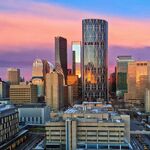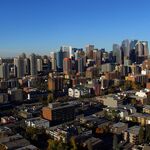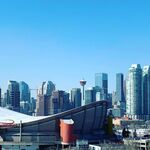UrbanWarrior
Senior Member
If Marlaina has any say in the name, it'll be something like ChemTrain, ChristRail... or something related to QAnon.
Today I had the opportunity to take the Hayabusa high speed train from Tokyo to Sapporo. Topping out at 320 km/h, Shinkansen trains like these allow both locals and tourists to cross the country in just hours.If Alberta had one we could get between Calgary and Edmonton in less than an hour!We are currently developing a Passenger Rail Master Plan for the province. More information on what it might look like is available at https://alberta.ca/passenger-rail
Straight and running along the highway the land is a lot less valuable and the highway already had unused ROW. The fact Deerfoot runs to near city centre also helps reduce the land needed within the city. The biggest downfall of California's HSR is the land acquisition and funding. California land is very valuable and most of the Central Valley is fertile farmland. The funding was also doled out in phases, with milestones, meaning the HSR authority had to acquire land, build, apply for next stage of funding, acquire, and build. This wasted a lot of time acquiring land and land owners were able to plan acquisitions to maximize value or drag out the process for years in the courts.Lol it is so funny to me that Danielle is a train enthusiast. I hate so much about her but this just goes to show, as a fellow train enthusiast, you can find common ground with anyone. Took HSR last week in France between Paris and Nice. I thought it was quite smart how through rural France they essentially ran the line through a ditch. Running the line in a ditch has so many benefits. Maybe not great for scenery as a rider but there were times I did get a good view of the country side. The relatively flat and straight corridor between Calgary and Edmonton would make it quite a lot easier than some other HSR lines.
This has been examined and rejected -- limits the design speed too much so reduces revenue more than the potential cost savings. Plus raises capital cost, all that crash barrier needed. .Straight and running along the highway the land is a lot less valuable and the highway already had unused ROW.
I don't think you need to run right along the QE2 and it might not actually be the optimal route because of the infrastructure required to take into account at all of the interchanges. Land costs are not going to be nothing but as you point out shouldn't be a huge detriment to the project. Getting out of Calgary isn't going to be that easy either there isn't much of a right-of-way along Nose Creek around 32nd and McKnight and I think the idea would be to twin the existing line that is there for regional rail and have HSR be its own separate thing. Maybe in the regional rail buildout they account for HSR in their land acquisitions.Straight and running along the highway the land is a lot less valuable and the highway already had unused ROW. The fact Deerfoot runs to near city centre also helps reduce the land needed within the city. The biggest downfall of California's HSR is the land acquisition and funding. California land is very valuable and most of the Central Valley is fertile farmland. The funding was also doled out in phases, with milestones, meaning the HSR authority had to acquire land, build, apply for next stage of funding, acquire, and build. This wasted a lot of time acquiring land and land owners were able to plan acquisitions to maximize value or drag out the process for years in the courts.
That's why the Florida HSR and the future Nevada/Texas HSR would likely be more successful, it's not some progressive vs conservative issue, but simply the routes taken.
Is there a reason why Brightline West is running in a highway median and doesn't have these issues?This has been examined and rejected -- limits the design speed too much so reduces revenue more than the potential cost savings. Plus raises capital cost, all that crash barrier needed. .
Brightline West does have these issues- it's just because of the extreme terrain that the tradeoff makes more sense. There are several points along the alignment where the train must slow for curves inside the RoW and several interchanges need to be rebuilt.Is there a reason why Brightline West is running in a highway median and doesn't have these issues?
There have been multiple corridors mapped out over the years.I think for HSR you want to run east of the QE2 pretty much along Range Road 12 all the way to Bowden.
That highway is straighter with a much wider median. Plus it would be impossible to get environmental approval otherwise.Is there a reason why Brightline West is running in a highway median and doesn't have these issues?
CP corridor isn't very direct as it cuts back/forth so it can pass through a couple of dozen small towns in its path. Would assume for HSR they would want to keep it as direct as possible and avoid all those towns as much as they can.I would have thought that HSR could have run along side the CP corridor. Is it an issue of CP not wanting that?
Caps speed at around 200 kph. The cost you might save, you end up having more grade separations, and revenue drops due to the speed drop. TBH 200 kph, with stations that have passing platforms everywhere, I could go for. Run expresses and locals, and turn the entire corridor into hybrid towns/suburbs. Would cost more and deliver less. But I could see it as a winning proposition. You can always add a true high speed ultra express later once the expensive bits accessing the cities is paid for with the amazing commuter system.I would have thought that HSR could have run along side the CP corridor. Is it an issue of CP not wanting that?
I always imagine commuter as heavy rail so it could use a twinned line on the freight tracks. I didn't think about having commuter and HSR using the same rails and tech. Maybe that is the way to go. Then is the only heavy line the one from the airport to downtown and on to Banff?Caps speed at around 200 kph. The cost you might save, you end up having more grade separations, and revenue drops due to the speed drop. TBH 200 kph, with stations that have passing platforms everywhere, I could go for. Run expresses and locals, and turn the entire corridor into hybrid towns/suburbs. Would cost more and deliver less. But I could see it as a winning proposition. You can always add a true high speed ultra express later once the expensive bits accessing the cities is paid for with the amazing commuter system.
The distance isn't actually that much longer. CP's Red Deer sub from 12th Street East to Red Deer is 95.6 miles. Highway 2 starting from 17th Ave SE to the Highway 11 overpass in Red Deer is ~91 miles.CP corridor isn't very direct as it cuts back/forth so it can pass through a couple of dozen small towns in its path. Would assume for HSR they would want to keep it as direct as possible and avoid all those towns as much as they can.




